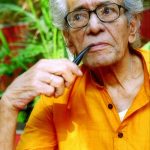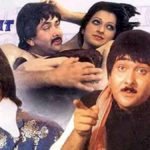 By Prof Satya Narayan Misra in Bhubaneswar, October 19, 2023: Habib Tanvir would have been 100 this month. His association with the stage spanned three-quarters of his life. He not only evolved a new style and idiom to his own work: but he also in some ways redefined the very concept of modernity in relation to culture.
By Prof Satya Narayan Misra in Bhubaneswar, October 19, 2023: Habib Tanvir would have been 100 this month. His association with the stage spanned three-quarters of his life. He not only evolved a new style and idiom to his own work: but he also in some ways redefined the very concept of modernity in relation to culture.
His journey into theatre brought forth a varied corpus of plays which included the adaptation of Sanskrit classics, Moliere, Bertolt Brecht, and Rabindranath Tagore. He was drawn to left-wing politics and became actively involved in its cultural movement which was led by the People’s Writer Association and IPTA.
Ali Sardar Jaffrey, Kaifi Azmi, Balraj Sahni, K.A. Abbas and Johra Sehgal were his initial associates and Bombay was the crucible in which Tanveer’s social and cultural consciousness was tempered. He left Bombay in 1954 for Delhi because cinema disillusioned him. He believed that there was no autonomy for artists and that the medium had to be theatre. He would be remembered for two great plays; Agra Bazar, Charandas Chor, and the controversial play Ponga Pandit.
Agra Bazar was based on the life and times of the 18th-century poet Nazeer Akbaradi. It was an astonishing play, where the protagonist Nazeer never appears in the play though a large corpus of his poems survives. No biographical information is available. He asked residents of Okhla village to act in the play; his first attempt to make theatre with rural folk. Habib’s rediscovery of Nazeer through drama can only be compared to Kabeer’s discovery by the singer Kumar Gandharv through music.
He left for London to be trained at the Royal Academy of Dramatic Art (RADA) but his ultimate interest was to meet Bertolt Brecht who was the presiding deity of a new form of theatre, epic theatre, in Berlin. Brecht was the leading theoretician of epic theatre which was a forum for disseminating political ideas and the creation of critical aesthetics for dialectical materialism.
Brecht believed that a play shouldn’t cause the spectator to identify emotionally with the characters or action before him but should instead provoke rational self-reflection and a critical review of the action. He believed in actors having direct access to the audience and used songs to interrupt action. Brecht hoped to refunction the theatre to a new social order and do away with the dichotomy between high art and pop culture.
Habib followed this nonconventional approach of Brecht and Naya Theatre was born in1959 with six actors from Chhattisgarh who were all unlettered but masters of rural theatre and dance. The actors danced with abandon, sang mellifluously, and spun magic around the rural audience. However, when these artists came to perform on the urban stage, they were stiff.
 Habib realized that when these local artists from Chhattisgarh were forced to speak in Hindi, a language that is alien to them, they were clearly hamstrung. When he asked them to speak in their local dialect it was magic, with their body and tongues unshackled. The actors were magnificent and the result was a stream of exceptionally good theatres like Charandas Chor, Mitti ka Gadi, and Sahaspur ki Shanti Bai based on Brecht’s eponymous play “The Good Person of Szechwan”. It was an unbridled cocktail of the plebeian and syncretic.
Habib realized that when these local artists from Chhattisgarh were forced to speak in Hindi, a language that is alien to them, they were clearly hamstrung. When he asked them to speak in their local dialect it was magic, with their body and tongues unshackled. The actors were magnificent and the result was a stream of exceptionally good theatres like Charandas Chor, Mitti ka Gadi, and Sahaspur ki Shanti Bai based on Brecht’s eponymous play “The Good Person of Szechwan”. It was an unbridled cocktail of the plebeian and syncretic.
In 1975, he wrote and directed Charandas Chor about a thief who is also a man of his word. The play is a marvellous example of his layered humanistic vision of the common man. He took a troop of sixty tribal folk artists to Edinburg where an exuberant frolicking group of villagers danced right into the hearts of European audience.
The Times London reported “Tanveer’s work comes from the point of view of the villagers. The Naya theatre position is closer to the unforgettable movies ofSatyajit Ray.” Peter Brook became his close ally during this European tour with folk artists from Chhattisgarh. It took the European audience out of the shackles of conservative theatre.
A theme that ran through all his creative art is the celebration of the plebeian. The culture, beliefs, and rituals of the Chhattisgarh peasants and tribal people their songs, and stories have given his theatre incredible vitality. Habib was fascinated by their eclecticism. He opposed Hindutva because it seeks to destroy freedom and regimented belief structure.
He represented two great traditions of Indian Theatre, the tradition of actor-director-play writer-manager and the tradition of an active involvement from the left-wing perspective in the larger social-political causes. He also fused the little tradition of Chhattisgarh tribal culture with India’s great tradition of multi-religious tolerance.
 After the demolition of Babri Masjid, his play Ponga Pandit invited the wrath of the Bajrang Dal in Madhya Pradesh. Ponga Pandit is a play about religious corruption and a few nerves were frayed during the increased politicization of the 90s, ushering in Hindu revivalism. He never shied away from airing contrarian political views. Ebrahim Alkazji, B. V. Karanth, Badal Sircar, Satyadev Dubey, and Habib Tanveer shaped the contours of modern Indian theatre.
After the demolition of Babri Masjid, his play Ponga Pandit invited the wrath of the Bajrang Dal in Madhya Pradesh. Ponga Pandit is a play about religious corruption and a few nerves were frayed during the increased politicization of the 90s, ushering in Hindu revivalism. He never shied away from airing contrarian political views. Ebrahim Alkazji, B. V. Karanth, Badal Sircar, Satyadev Dubey, and Habib Tanveer shaped the contours of modern Indian theatre.
Like Alkazihe went to England to get training in the theatre but unlike him, he shed his learning like a snake’s skin. Like Karanth he experimented extensively with a theatrical form but unlike him, he always stayed close to European theatre, particularly Brecht. Amid the polished actions of Anglophobic theatre in Delhi, he staged the noisy cacophonic marketplace of Agra Bazar, paying homage to the 18th-century Urdu poet who wrote verses on demand for market vendors.
Delhi of the 70s resonated with the controversial theatre of Suresh Tendulkar’s Sakharam Binder, the iconoclasm of B. V. Karanth’s play Ghasiram Kotwal, and Alkazi’s eponymous play Tughlaq on the ramparts of Delhi old fort. It is to the credit of Habib Tanveer that he staged a theatrical coup that could take out an exuberant frolicking group of tribal artists of Chattisgarh, adored wherever it was performed; Chattisgarh, Delhi, or Edinburg.
By preserving the local dialect, he could bridge the gap between the rural and the urban audience, the Hoi polloi, and the elite. He was a non-practicing Muslim married to Hindu Brahmin, Tanveer was a formidable intellectual with deep insights about the Natya Shastra and India’s popular tradition. He was a sophisticated aesthete who soaked up the influences from all over the world and a citizen activist committed to the values of secularism and social justice.
He used to say “In India, the economically poorer are culturally the richest”. He devoted his entire life and art to uplifting the culture and voice of India’s poorest. He would have been deeply anguished by the attempt of the BJP to foment religious fundamentalism.
• Satya Misra is a theatre buff.



Leave a Reply
Be the First to Comment!